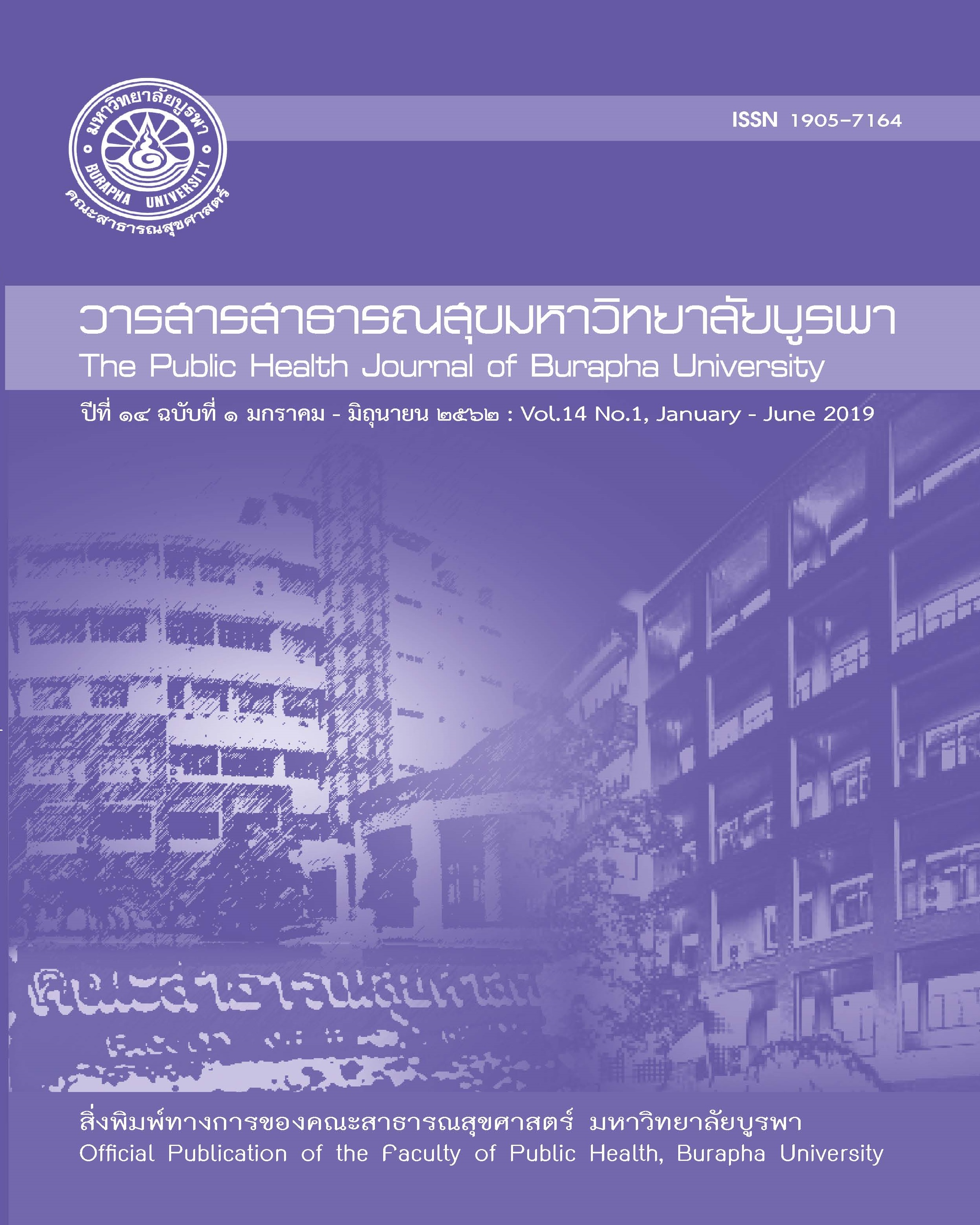การพัฒนาเมตริกความเสี่ยงทางอาชีวอนามัยเพื่อการเฝ้าระวังการรับสัมผัสสารพาราควอต ในเกษตรกรผู้ฉีดพ่นสารพาราควอต
Main Article Content
บทคัดย่อ
The Development of Occupational Health Risk Matrix for Surveillance of Paraquat Exposure
among Paraquat Knapsack Spraying Farmers
การศึกษารูปแบบภาคตัดขวางเชิงสำรวจนี้มีวัตถุประสงค์เพื่อพัฒนาเมตริกความเสี่ยงทางอาชีวอนามัยต่อการรับสัมผัสสารพาราควอต เก็บข้อมูลโดยสัมภาษณ์ผู้ฉีดพ่นอำเภอหนึ่ง ในจังหวัดขอนแก่น ใช้ข้อมูลส่วนบุคคล การทำงาน เพื่อประเมินการการรับสัมผัสสารพาราควอตผ่านการหายใจ และพัฒนาเมตริกความเสี่ยงที่พิจารณาความรุนแรงจากอาการผิดปกติ พิจารณาโอกาสจากความถี่การรับสัมผัสร่วมกับค่ามัธยฐานความเข้มข้นของสารพาราควอต เท่ากับ 6.851 µg/m3 ที่เก็บตัวอย่างอากาศในกล่องทดลอง (n=7) พบการรับสัมผัสอยู่ในช่วง 0.006-2.527 µg/kg/day สามารถอธิบายได้ว่าการรับสัมผัสสารพาราควอตทางการหายใจที่ความเข้มข้นต่ำกว่าร้อยละ 10 ของ OEL (100 µg/m3) มีความเสี่ยงต่อสุขภาพสูงกว่ายอมรับได้จากเมตริกความเสี่ยงทางอาชีวอนามัยร้อยละ 34.48 จากสมการคำนวณต่อการรับรับสัมผัส (เมื่อ HQ>1) ระยะยาวร้อยละ 10.34 ระยะสั้นร้อยละ 10.34 ผลจำเพาะต่อปอดร้อยละ 0.00 ดังนั้นข้อมูลนี้จึงมีประโยชน์ต่องานด้านสาธารณสุขและเกษตรกรผู้ฉีดพ่นเพื่อให้เกิดการเฝ้าระวังอันตรายทางสุขภาพจากการรับสัมผัสสารพาราควอต และการป้องกันการรับรับสัมผัสสารพาราควอตเข้าสู่ระบบทางเดินหายใจขณะฉีดพ่น โดยนำเมตริกความเสี่ยงทางอาชีวอนามัยนี้ไปทดลองใช้ประเมินความเสี่ยงของเกษตรกรผู้ฉีดพ่นที่มีการตรวจวัดความเข้มข้นของสารพาราควอตจริง เพื่อการเผยแพร่เมตริกความเสี่ยงนี้ไปใช้ในการเฝ้าระวังการรับสัมผัสสารพาราควอตต่อไป
The cross-sectional survey study aimed to develop an occupational health risk matrix on airborne paraquat exposure of knapsack sprayers. The study conducted in paraquat knapsack sprayers in one district of Khon Kaen province, Thailand. Personal and working characteristics of sprayers were used for inhalation intake estimation and develop occupational health risk matrix severity concerned adverse symptoms experience, considering likelihood of paraquat exposure and concentration (were calculated at median airborne paraquat concentration 6.851 µg/m3 from the experimental model n=7). The estimation intakes ranged between 0.006-2.527 µg/kg/day. It can be explained that exposure to paraquat on inhalation route at the concentration which was lower than 10% of the occupational exposure limited level (OEL=100 µg/m3) had higher risk than an acceptable level from occupational health risk 34.48%, from risk estimation was presented by hazard quotient (when HQ>1) 10.34% of knapsack sprayers were at risk of long-term exposure, 10.34% for short-term exposure, 0.00% for chronic pneumonitis. The finding risk matrix is useful for public health sectors and sprayers for the surveillance program and prevention on inhalation exposure to paraquat while field spraying. The measurement of inhaled paraquat while spraying for concentration used in the developed matrix would support further the distribution of this occupational health risk matrix in health surveillance program of paraquat exposure.
Article Details
เอกสารอ้างอิง
2. สำนักควบคุมโรคและวัสดุการเกษตร. รายงานสรุปการนำเข้าวัตถุอันตรายปี 2559 [online]. เข้าถึงได้จาก https://www.doa.go.th/ard/ (วันที่ค้นข้อมูล 21 มีนาคม 2560).
3. ศูนย์พิษวิทยารามาธิบดี. ภาวะเป็นพิษจากพาราควอต [online]. เข้าถึงได้จาก https://med.mahidol.ac.th/poisoncenter/th/pois-cov/สารพาราควอต (วันที่ค้นข้อมูล 4 มีนาคม 2560).
4. กระทรวงสาธารณสุข. ฐานข้อมูลสุขภาพ [online]. เข้าถึงได้จาก https://hdcservice.moph.go.th/hdc/main/index_ pk.php (วันที่ค้นข้อมูล 29 กรกฏาคม 2560).
5. Fortenberry GZ, Beckman J, Schwartz A, Prado JB, Graham LS, Higgins S, et al. Magnitude and characteristics of acute paraquat and diquat related illnesses in the US: 1998-2013. Environ Res. 2016 Apr; 146: 191-9.
6. Kumar H, Singh VB, Meena BL, Gaur S & Singla R. Paraquat poisoning: A case report. J Clindiagn Res. 2016; 10(2): 10–1.
7. Patil VS & Patil GV. A study of paraquat poisoning. IJSR. 2016 March 5(3): 118-21.
8. จุฑามาศ ฉากครบุรี และสุนิสา ชายเกลี้ยง. การประเมินความเสี่ยงต่อสุขภาพจากการรับสัมผัสสารพาราควอตในผู้ฉีดพ่น. วารสารความปลอดภัยและสิ่งแวดล้อม. 2560; 2(1): 23-30
9. พันธ์เทพ เพชรผึ้ง. ผลกระทบทางสุขภาพจากการใช้พาราควอตและแนวทางจัดการความเสี่ยง กรณีศึกษา ตำบลปงสนุก อำเภอเวียงสา จังหวัดน่าน. วารสารเภสัชกรรมไทย. 2558; 7(2): 250-8.
10. Morshed MM, Omar D, Mohamad R, Wahed S & Rahman MA. Airborne paraquat measurement and its exposure to spray operators. IJABE. 2010; 12(5): 679–84.
11. American Conference of Governmental Industrial Hygienists. TLVs and BEIs. United State; 2018.
12. The National Institute for Occupational Safety and Health (NIOSH). Paraquat (Paraquat dichloride). Available at https://www.cdc.gov/niosh/npg/npgd0478.html, accessed June 28, 2018.
13. สุนิสา ชายเกลี้ยง และอาริยา ปานนาค. การประเมินความเสี่ยงด้านสุขภาพต่อการปวดไหล่ในพนักงานผลิตและประกอบชิ้นส่วนอิเล็กทรอนิกส์. วารสารสาธารณสุขศาสตร์. 2017; 47(2): 212-21.
14. กำหนดมาตรฐานผลิตภัณฑ์อุตสาหกรรม การประเมินความเสี่ยงด้านสารเคมีต่อสุขภาพผู้ปฏิบัติงานในโรงงานอุตสาหกรรม. ประกาศกระทรวงอุตสาหกรรม ฉบับที่ 4439 (พ.ศ. 2555). ราชกิจจานุเบกษา เล่มที่ 129, ตอนพิเศษที่ 146 ง. (ลงวันที่ 21 กันยายน 2555)
15. สุนิสา ชายเกลี้ยง. (2557). พิษวิทยาสาธารณสุข. ขอนแก่น: โรงพิมพ์มหาวิทยาลัยขอนแก่น.
16. สำนักโรคจากการประกอบอาชีพและสิ่งแวดล้อม. แบบประเมินความเสี่ยงในการทำงานของเกษตรกรจากการรับสัมผัสสารเคมีกำจัดศัตรูพืช (นบก. 1-56) [online]. เข้าถึงได้จาก https://envocc.ddc.moph.go.th/ (วันที่ค้นข้อมูล 3 มีนาคม 2559).
17. Occupational Safety and Health Administration: OSHA 2006 Air Contaminants 29 CFR 1910.1000. Available at: https://www.osha.gov/dsg/annotated-pels/, accessed April 25, 2018.
18. ขีดจำกัดความเข้มข้นของสารเคมีอันตราย. ประกาศกรมสวัสดิการและคุ้มครองแรงงาน, ราชกิจจานุเบกษา เล่มที่ 134, ตอนพิเศษที่ 198 ง. (ลงวันที่ 3 สิงหาคม 2560).
19. Risk assessment guidance for superfund volume I: Human health evaluation manual supplemental guidance “Standard default exposure factors” interim final. U.S. EPA. United State: Washington D.C.; 1991.
20. European commission. Paraquat, 2003. Available at https://ec.europa.eu/food/plant/pesticides/eu-pesticides-database/public/?event=activesubstance.detail&language=EN&selectedID=1669 (accessed December 28, 2017).
21. Integrated Risk Information System: United States Environmental Protection Agency. Paraquat [online]. Available at https://cfpub.epa.gov/ncea/iris2/chemicallanding.cfm?substance_nmbr=183 (accessed March 2, 2017).

